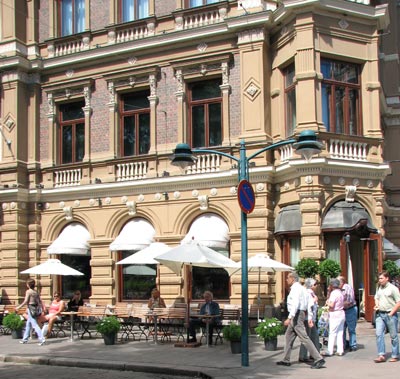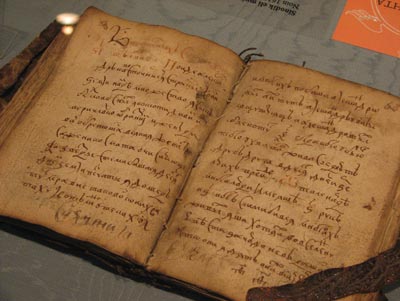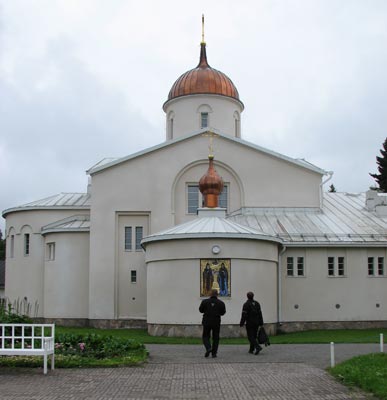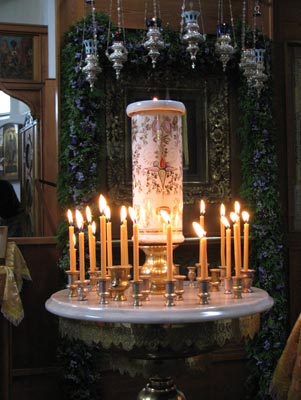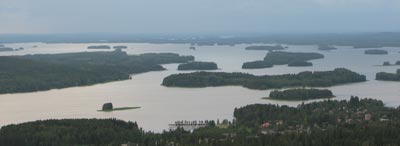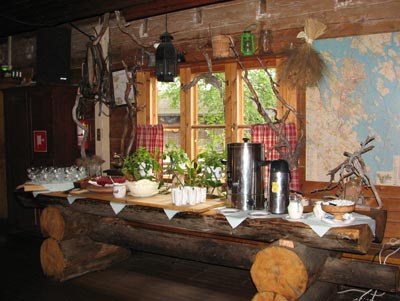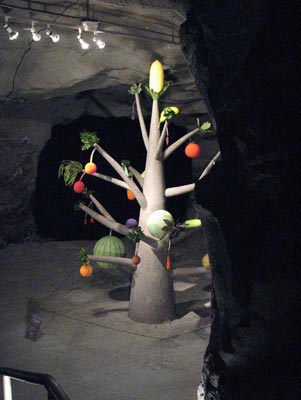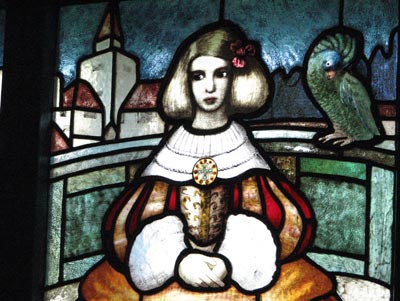Discovering Finland's Lake District plus Helsinki and the Savonlinna Opera Festival
by Beth Habian, Features Editor
They call it “The Land of a Thousand Lakes,” although the brain behind that marketing campaign should have invested in a calculator, as the actual number is closer to 200,000! Whatever the number, Finland’s lake-filled landscape is one of the major draws for visitors to this relatively remote European country.
In July ’07 I had the opportunity to visit Finland’s Lake District, the largest in Europe, and get a glimpse of modern city life in Helsinki, rounding it all off with a bit of high-brow happenings at the annual Opera Festival in Savonlinna. What I experienced was a country that was a little quirky and, oftentimes, not what I expected.
Helsinki
I started my explorations in Finland’s capital city. After checking in at the modern Scandic Hotel Simonkenttä (Simonkatu 9; www.scandic-hotels.com — rooms from around €100, double, including breakfast), I strolled down to the tree-lined Esplanadi boulevard and the Helsinki Expert Tour Shop located at the end of Esplanadi Park.
Helsinki Expert (Lönnrotikatu 7B; phone +358 [0] 9 2288 1200, www. helskinkiexpert.fi) offers sightseeing tours in and around Helsinki as well as throughout Finland and the neighboring countries of Estonia, Russia and Sweden.
I was scheduled to take the 1½-hour audio tour of the city (€25, or $35), a bus tour which offers recorded commentary in 12 languages (including Latin!) and visits the main sights in Helsinki, including Senate Square, the Sibelius Monument and the Temppeliaukio Church (Rock Church).
It was a wonderful way to get a feeling for the overall layout of the city plus get an introduction to the history of Finland in general and Helsinki in particular. It was just enough information for my jet-lagged mind to handle.
Note: this tour, which operates daily at 11:00 (and at 12, 1 and 2, depending on the season), is free with the Helsinki Card (€33, or $47, for a one-day card), which offers free entry to all major sights and over 50 museums plus unlimited travel on public transport within the city.
After a bit of rest back at the hotel, it was time to meet my group of fellow journalists for dinner at the nearby Ravintola Loiste (3 Kaivokatu; www.ravintolaloiste.fi), located on the 10th floor of the Sokos Hotel Vaakuna.
The restaurant’s interior, designed to look like a ship, felt a bit dated — something that, I would come to discover, was not particularly unusual for the Finland I saw. Overcoming that obstacle, however, were the clean-cut, attentive young waiter and the well-presented food.
The menu offered a nice variety, from tapas-type selections starting at €4.50 per plate to main courses starting around €15; my entrée of sautéed whitefish (€23) was tasty.
On to Kuopio
The next morning started with a 4½-hour train trip to the town of Kuopio in eastern Finland. Kuopio is famous for two things: its traditional fish bread, called kalakukko, and the landmark Puijo Tower. I had a date with them both.
From the market square, we walked to the Pikku-Pietarin market alley (follow Tulliportinkatu to Hatsalankatu), a small strip of artisan shops plus a café housed in what once were stables.
In the café, which welcomed us with the warm scent of cinnamon, we were treated to some of the local baked goods, including the much-talked-about kalakukko. As I like my bread sans small fishes, I opted for the traditional Karelian rice-filled pastry instead, lavishly spreading it with egg butter as instructed by our gracious hostess. I was happy with my choice.
Continuing our day of things traditionally Finnish, we were headed for the one thing held dear in the heart of every Finn: the sauna. Now, I knew the sauna was a popular tradition in Finland. I didn’t know it was the equivalent of a Starbucks in any major U.S. city. They’re everywhere!
There are saunas on top of office buildings and saunas in every hotel, and modern apartments are built with individual saunas for each unit. According to the Finnish Tourist Board, there are 1.6 saunas for every Finn in Finland.
We were headed for the smoke sauna at Jätkänkämppä Lumberjack Lodge (phone +358 [0] 30 608 30), touted to be the world’s largest sauna of its kind.
Traveling in small motorized boats across Lake Kallavesi, we soon arrived at the rustic lodge, part of the Spa Hotel Rauhalahti (www.rauhalahti.fi). The lodge is open on Tuesdays throughout the year (and Thursdays during the summer), and the smoke sauna is available for public use for €10 per person.
The lodge also offers a traditional dinner buffet on Tuesdays (€18 per person), which, after a half hour of “research” in the on-site facilities, our group enjoyed — everyone sitting around the table relaxed and smelling like a campfire.
Only a few hours later we would eat again, this time at the top of Kuopio’s second claim to fame: the Puijo Tower. Built in 1963, the 246-foot-high tower is topped with an observation deck and a revolving restaurant. Again, the décor left something to be desired, but the food wasn’t bad; I was especially impressed with the starter, a creamy morel soup (€8).
Unfortunately, the weather wasn’t the best. As a result, the “spectacular” views over the city and the surrounding lakes weren’t. I made it out on the deck just long enough to snap a few pictures over the edge before being blown back inside by the freezing wind.
Finding religion
In this part of Finland especially, although it is true across the country, the Finnish Orthodox Church is strongly acknowledged, even though its members make up only one percent of the population. Together with the Evangelical Lutheran Church, it holds the position of a national church in Finland.
In Kuopio we visited the Orthodox Church Museum (Karjalankatu 1; www.ort.fi/kirkkomuseo), which houses an impressive collection of icons and other sacred objects gathered mainly from the evacuated monasteries and congregations of Karelia, a region of southeast Finland that was divided between Russia and Finland during WWII.
The building’s starkly modern facade gave no hint of the rich treasures it held within: a sizable collection of gilded and bejeweled Byzantine-style icons, antique handwritten texts and ornately embroidered liturgical textiles. The items, most of which date from the 18th to 19th centuries, were well displayed, although descriptions were not available in English. Admission was €5 per adult or €4 senior.
Leaving Kuopio the next morning to visit another religious site, the Orthodox monastery of New Valamo in Heinävesi, we hopped aboard the m/s Puijo, the ferry that runs from Kuopio to Savonlinna and back in the summer months.
Departing from Kuopio at 9 a.m. on Tuesdays, Thursdays and Sundays from June through August (beginning and end dates vary, so check before you travel), the entire journey takes 10½ hours and costs €75 ($107) per adult. However, the boat makes 10 stops along the way and passengers can get on/off at any of these points; we disembarked at Heinävesi, four hours into the journey.
The price for our portion of the boat ride was €32. Tickets can be purchased at the port in Kuopio (Matkustajasatama), directly from the boat or from the tourist information office. It’s advisable to book in advance.
A short bus ride later we were at the monastery, which receives more than 160,000 visitors each year. The original monastery at Valamo, in Karelia, was evacuated after the area was ceded to Russia, and the community of about 200 monks settled at what is now New Valamo (Valamontie 42, 79850 Uusi-Valamo; fax +358 [0] 17 5701 510, www.valamo.fi).
Today, it still functions as the home of the monks, although their numbers are fewer (around 10). However, their primary source of income is tourism, and in addition to souvenir and wine shops there is a cafeteria-style restaurant that serves buffet breakfast, lunch and dinner daily (approximately €12 for lunch).
Guided tours of the grounds are available, and overnight accommodation and special Easter and Christmas packages are offered. Those looking for a more hands-on experience can participate in a workshop at the monastery’s Lay Academy (such as their icon-painting workshop), offered each year in English, by arrangement.
In contrast to the highly decorated interiors of the Orthodox churches at Valamo, the spartan interior of the Lutheran Kerimäki Church, about 1½ hours away by car, was surprising. However, it was size, not style, that made this church impressive.
The largest wooden church in the world, Kerimäki was designed to hold 5,000 worshipers at once, half the area’s population at the time it was built in the mid-1800s. My overall impression? Yep, it’s big!
The Lake District
We were now technically in the Lake District, which brought to mind serene vignettes of boats on the water and majestic pine forests. What I wasn’t prepared to see, as we pulled up to our hotel, Herttua (Veneenniementie 64, Kerimäki; www.herttua.fi), were the WWII-era tank and heavy artillery gun that greeted us upon arrival in the parking lot. This permanent exhibition of Finnish military equipment on the grounds of the hotel is perhaps the most bizarre thing I have ever encountered at a lakeside accommodation.
Inside, the hotel could use some updating, but the location, on Lake Puruvesi, was quite pleasant, the rooms were clean, the staff was friendly and the prices (starting at €99, or $140, for a single during high season) were reasonable.
The hotel’s restaurant served a nice dinner, and I just had to try the dessert which listed “tar” as one of its main ingredients (come on, how can you not?!). Apparently, pine tar is not an ingredient unheard of in Finnish cooking, and it has a flavor similar to liquid smoke — not so great, it turns out, in ice cream or over pineapple.
The next morning found us at the nearby Retretti Arts Centre (phone +358 15 775 22 00, www.retretti.fi) in Punkaharju. This interesting art center houses traditional art galleries aboveground as well as an underground cave system covering 3,700 square meters.
The manmade space offers visitors a unique venue in which to view the modern art on display — a definite break from the typical stark white exhibition spaces of most conventional galleries. During my visit, there was a variety of exhibitions, from fun (and some strange) conceptual works “downstairs” to a beautiful anniversary exhibition of pieces by Kalevala Koru, Finland’s leading jewelry manufacturer, in the upper gallery.
Retretti is open during the summer months only (June through August), from 10 a.m. to 5 p.m. Admission is €15 per adult or €13 senior. A restaurant and a gift shop are on site.
The next item on my itinerary said “lumber museum” and, I must admit, I didn’t expect much. But Lusto (Lustontie 1, Punkaharju; www.lusto.fi), the Finnish Forest Museum, was interesting. (I was oddly fascinated by the colorful wall display of chainsaws.) The history of the lumber industry in Finland was traced through artful displays, including vintage photos and video footage, and there were quite a few interactive exhibitions for kids. All in all, it was an informative visit.
Open daily from May through September (Tuesday-Sunday in other months and closed January), admission costs €7 per adult or €6 senior. Combo tickets for entry to Lusto and Retretti are available for €20 per adult (€16 senior).
Savonlinna Opera Festival
The time had come for the highlight of our tour: the Savonlinna Opera Festival. Held each July, the opera festival, which draws audiences from around the world, takes place in the medieval Olavinlinna Castle, situated on a rocky island in Lake Saimaa — quite a dramatic setting.
We got situated in our hotel, Hotel Tott, the only hotel I actually was disappointed with on this visit (a small, uncomfortable bed and not-so-friendly staff) but perhaps the best thing available due to overbooking during the festival.
Then I took a quick stroll around the quaint town of Savonlinna before meeting my group for dinner at what was described as a “medieval restaurant.” I was a little worried. I had been to this sort of place before and it usually meant a lot of kitsch and very little good food. Boy, was I wrong!
Hilpeä Munkki (phone +358 15 515 330 during the summer or e-mail hilpea munkki@saimaa holiday.net), which sits on the shore of the lake in the shadow of Olavinlinna Castle, was decorated in simple medieval style, with terra-cotta vessels of wildflowers adorning the large plank tables.
The atmosphere was wonderful, and the food — a huge plate of assorted smoked and cured fish (€11) followed by absolutely perfectly prepared elk in a wine sauce (€24) served in a cast-iron skillet — was the best meal I had, by far, while in Finland. The panna cotta served for dessert and the wine from Chile didn’t exactly fit the medieval theme, but they were fabulous, nonetheless. The restaurant is open in the summer only, from the end of June to mid-August.
Sated, we waddled over to the castle for that evening’s performance of Bizet’s “Carmen.” It was a full house and the opera, executed by a combination of local artists and members of the visiting Bolshoi Theatre of Moscow, was great.
The 2008 festival runs from July 4 to Aug. 2 and will feature the visiting Shanghai Opera House. Performances will include Verdi’s “Rigaletto” and “Aida” and Wagner’s “The Flying Dutchman” plus the featured opera, Arrigo Boito’s “Mefistofele.” The festival also offers special concerts and children’s productions.
Tickets, which can be purchased online, range from €30 to €200 ($43-$284), depending on seat and performance. For more information, contact the Savolinna Opera Festival (fax +358 [0] 15 476 7540, www.operafestival.fi).
Returning to Helsinki
It was the end of our group tour, but I was returning for one more day in Helsinki on my own before flying home. On my way back into the city, I stopped for lunch at Krapihovi (Rantatie 2; phone [09] 274 841, www.krapi.fi), located on the Krapi estate in Tuusula.
The estate, which includes a beautifully decorated hotel housed in what once was the old cowshed, plus several restaurants and a covered summer theater, is located by Lake Tuusulanjärvi just 30 kilometers outside Helsinki. However, you are enveloped by nature here — a really lovely area to stay while still having easy access to the city.
Krapihovi is situated in a homey 19th-century building, the former main residence of the estate. The restaurant specializes in traditional Finnish cuisine and offers special summer and autumn buffet lunches (€30.50 Monday-Saturday, €33 Sunday) in addition to à la carte selections. I would definitely stop in again.
After lunch I continued on to the city, checking in at the chic Hotel GLO (Kluuvikatu 4; www.palacekamp.fi). I liked this hotel for its location, just a couple minutes’ walk from Esplanadi Park and Senate Square (in opposite directions), as well as for its sleek, urban style and the simple yet yummy breakfast buffet in its Catalonian-inspired La Cocina restaurant. The hotel also features a full-service day spa (with, you guessed it, different kinds of saunas). Double rooms start around €150 ($213) including breakfast.
For my final day in Finland I would again take advantage of the services offered by Helsinki Expert. I was booked on a half-day tour to visit Hvitträsk, the studio home of Finnish architects Herman Gesellius, Armas Lindgren and Eliel Saarinen, and the nearby home of Finnish composer Jean Sibelius.
Located in Kirkkonummi, about 18 miles from Helsinki, Hvitträsk was a real treat to explore. It was built in the National Romantic style, which reflects influence from the British Arts and Crafts movement, but it includes some whimsical design elements that represent the eclectic tastes of the occupants and their artistic friends. The home is surrounded by beautiful gardens and offers views of the nearby lake.
I was less impressed with Ainola, the former home of Jean Sibelius, which restricted public access to a small area and was not as pleasing, to me, in its design. But, for its historical importance, it was an interesting place to visit and the local guide was quite knowledgeable.
I would highly recommend this half-day tour. At €52 (€45 with the Helsinki Card), it included bus transportation, guide services, entrance tickets and locally guided tours of each site.
Our Helsinki Expert guide also was wonderful. She was very informative, giving us some history on the places we were going to and the area in general without duplicating information we would be getting on our local tours, plus she kept everyone organized, had a great sense of humor and even gave us tips on what to do in the evening after our return to the city.
Summing up
With all that Finland has to offer, I’d have to say the sheer beauty of the countryside is the thing that sticks with me the most.
On my way back to Helsinki, I was dozing on the 4½-hour bus ride from Savonlinna to Mäntsälä. Upon waking, the first thing I saw when I opened my eyes was a glorious field of blue delphinium surrounded by lush green pines topped by fluffy white clouds just waiting to be plucked from the incredibly blue sky.
My first thought? “This is why you come to Finland!”
Beth Habian was a guest of the Finnish Tourist Board (www.visitfinland.com). Their U.S. representative is Maria Sarvanski at Aviareps (1 Penn Plaza, Ste. 1926, New York, NY 10119; 212/885-9700; contact.usa@visitfinland.com).



